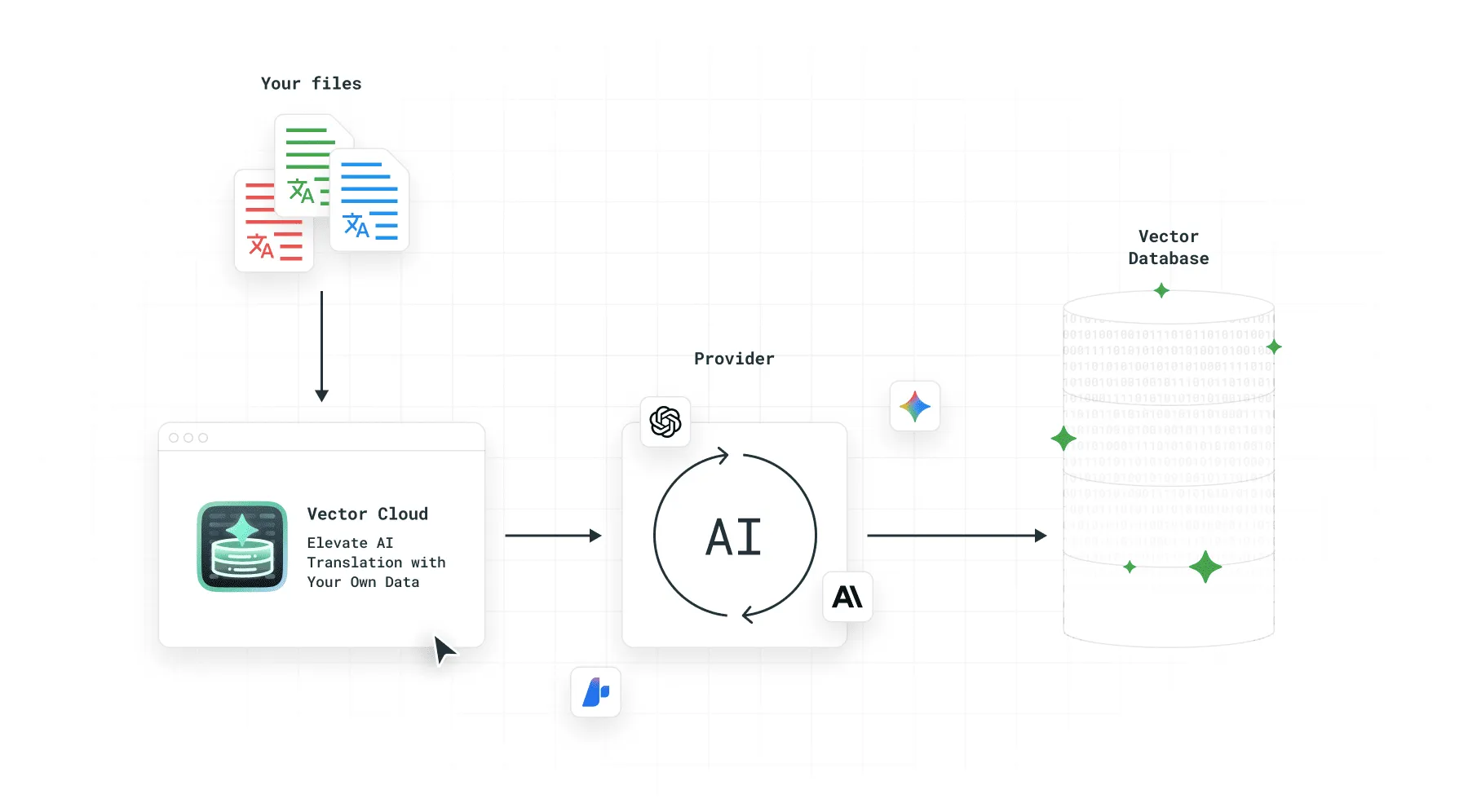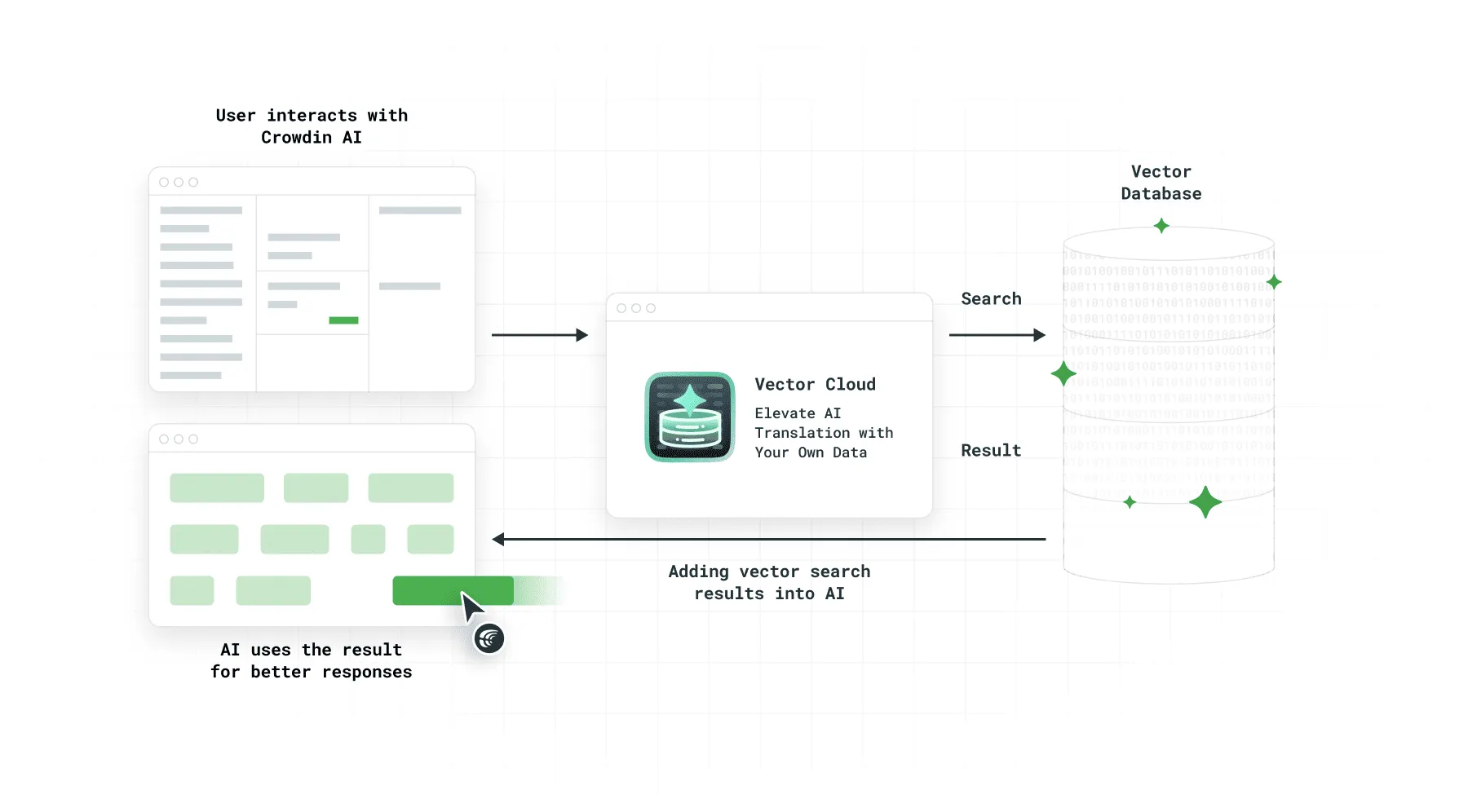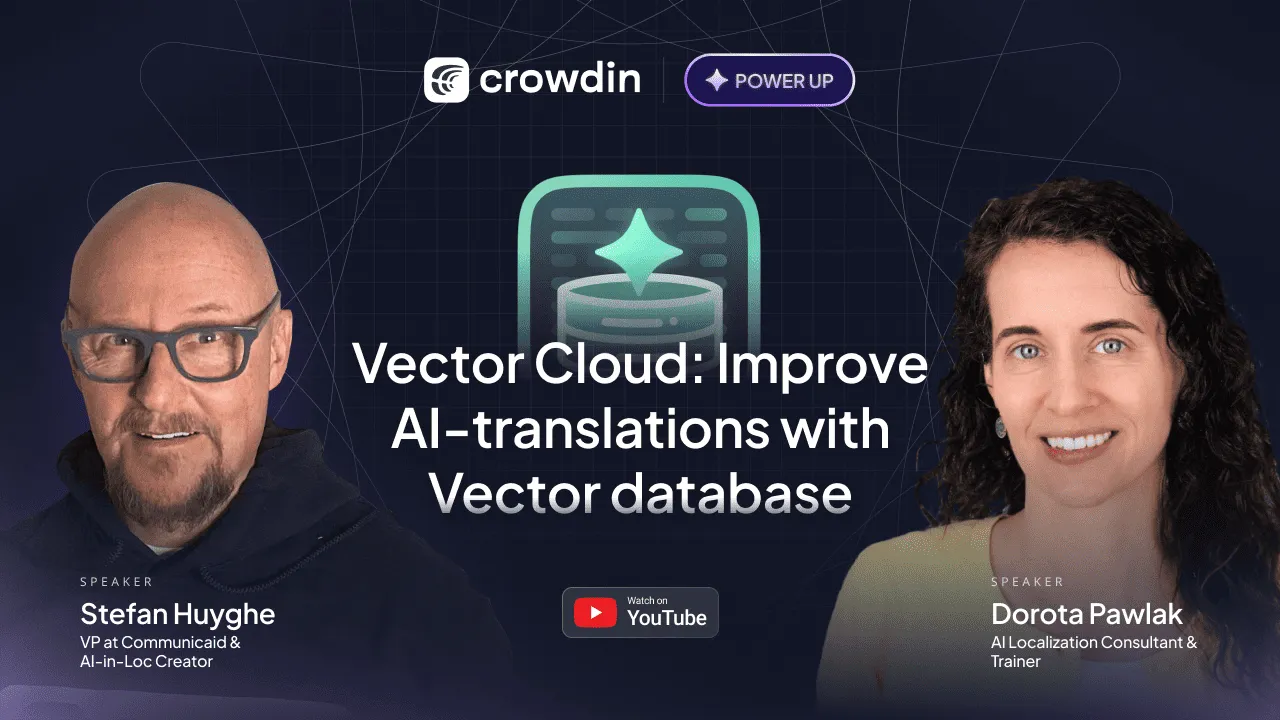In localization, context is king. But what if your most valuable brand context – the nuances, the terminology, the single creative phrases – was locked away? For too long, your AI models couldn’t fully use that data.
Previously, we’ve relied on traditional Translation Memory (TM) fuzzy matches, often overlooking anything below 50% or even 10% similarity. Those “tiny matches” contain critical stylistic and terminological clues, but they rarely get displayed or used in our workflows.
Crowdin’s new Vector Cloud app is here to change that, transforming AI translations, by enabling ai to use the most of available context.
In the fourth episode of Crowdin Power Up, host Stefan Huyghe and AI localization expert Dorota Pawlak dived into Vector Cloud. They demonstrated exactly what this is, how to set it up, and how to work with it to transform your AI translation workflows.
The Magic Pot of Context
Vector Cloud is a powerful new tool that uses a vector database to provide semantic, context-aware input to your AI translation models. It’s like a “magic pot”. You can throw in any text you think might be useful – and the AI will pull out the relevant data to improve your new translations.
What makes it revolutionary?
-
Instead of just looking for exact string similarities, Vector Cloud uses semantic vector search. It understands the meaning and context of your content, retrieving relevant examples even if the text overlap is minimal.
-
You can upload any text file to Vector Cloud:
- Parallel texts
- Style guides (as a reference, even if they aren’t a standard TM)
- Reference documents, even if they are monolingual
- Any other texts, even those with just a few important words or phrases.
-
By feeding the AI your preferred style, you make your translations more consistent with previously created content, matching terminology and tone. As our demos show, this also helps to generate more creative and fluent translations that go beyond the literal.
How does the Vector Cloud app work?
We’ll try to answer this question as simply as possible, starting with the initial steps:
- You send source content to the Vector Cloud app.
- The application processes the files.
- Embedding Provider (AI) processes the content.
- Vectors are stored in a Vector Database.

When you use the AI Assistant or AI pre-translate in Crowdin, it triggers Vector Cloud. How it looks:
- User interacts with Crowdin to do an AI-related action.
- Vector Cloud searches the Vector Database. It’s looking to find the most relevant stored vectors.
- The most similar historical content is fetched.
- The app includes the found content and adds the result to the action.
- The AI Assistant or AI pre-translate leverages that context to provide a more informed and accurate output.
That’s how this process can be visualised:

Now let’s move to the practical examples.
Vector Cloud in Action: Translation & QA
We’ve seen Vector Cloud in two compelling scenarios:
1. Improving AI Pre-translation
Without Vector Cloud, Agentic AI, while smart, can sometimes produce translations that are too literal.
For instance, translating “enjoy a home that adapts to you” for a smart home app literally might miss your brand’s creativity.
- Before Vector Cloud: The translation was literal, missing the desired creative tone.
- With Vector Cloud: By adding a style guide and target-language-only reference documents (showing the preferred style), the Agentic AI produced a translation that was more creative and natural-sounding, like “your home will become a space adapted to you”, perfectly aligning with the unique style guide.
2. Adjusting AI-Based Quality Assurance (QA)
Creative translations often trigger false positives in traditional QA checks because the AI is trained to flag literal deviations. Vector Cloud lets you fine-tune the QA process in the opposite direction.
- Before Vector Cloud: An AI QA check flagged a translation that used the word “song” instead of “playlist” as inaccurate (even if the creative translation was approved in the brand’s style guide).
- With Vector Cloud: By uploading a reference text and a style guide that says to be “creative and transcreate”, the AI model learned the desired style. When the QA check ran again, it found no issues, correctly marking the creative translation as accurate.
So now you can tell the AI “My text has to be creative”, virtually eliminating false error flags on creative translations.
Get Started: Setting Up Vector Cloud
It’s simple to bring this power to your projects:
- Install the App: Find and install the Vector Cloud app from the Crowdin App Store.
- Configure Embedding Provider: In the settings, add your API key for an embedding provider (like OpenAI) under the Extensions tab.
- Content Sources: Select which existing Translation Memories and Glossaries you want to sync automatically.
- Data Synchronization: Enable “Sync now” so any new entries in your TMs/Glossaries are automatically updated in Vector Cloud, keeping your context fresh.
- Enhance AI Prompts: Enable the feature to let the vector database look through your data, pick the most relevant context (meaning, not just words), and add these extra clues to the Agentic AI prompt. This ensures the AI output matches your brand’s preferred terminology, tone, or phrasing.
- Upload Documents: Upload up to 10 custom files – style guides, manuals, parallel texts, etc. Supported formats include PDF, DOCX, CSV, and more.
What This Means for You
Vector Cloud is a huge shift in the localization world. For linguists, Vector Cloud lets you finally put your unique creative expertise to work with AI. You’re not just correcting literal errors anymore – you’re the creative director, guiding the AI with all your knowledge and style preferences.
Localize your product with Crowdin
Yuliia Makarenko
Yuliia Makarenko is a marketing specialist with over a decade of experience, and she’s all about creating content that readers will love. She’s a pro at using her skills in SEO, research, and data analysis to write useful content. When she’s not diving into content creation, you can find her reading a good thriller, practicing some yoga, or simply enjoying playtime with her little one.
